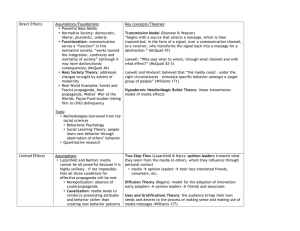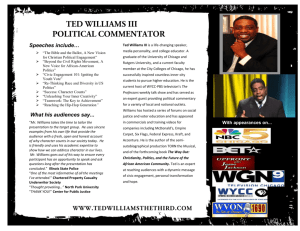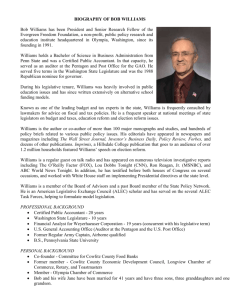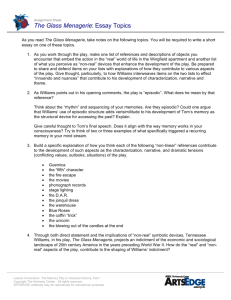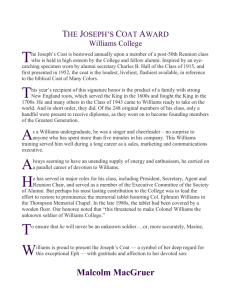“Mass” in Communication Research
advertisement
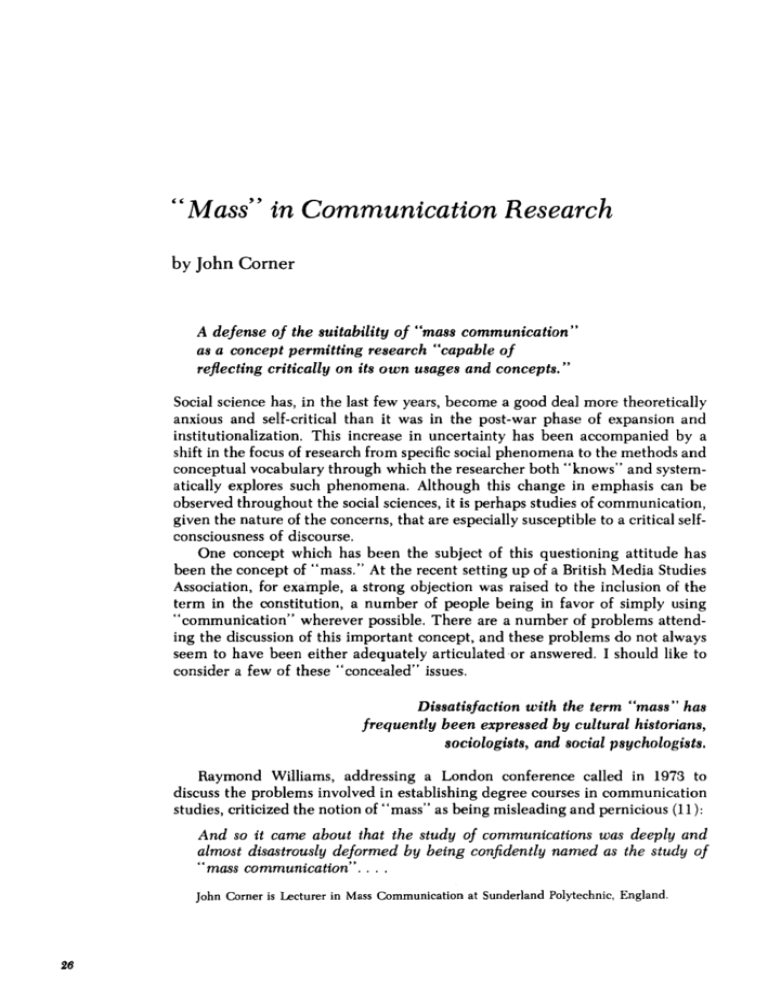
“Mass” in Communication Research by John Corner A defense of the suitability of “mass communication” as a concept permitting research “capable of reflecting critically on its own usages and concepts.” Social science has, in the last few years, become a good deal more theoretically anxious and self-critical than it was in the post-war phase of expansion and institutionalization. This increase in uncertainty has been accompanied by a shift in the focus of research from specific social phenomena to the methods and conceptual vocabulary through which the researcher both “knows” and systematically explores such phenomena. Although this change in emphasis can be observed throughout the social sciences, it is perhaps studies of communication, given the nature of the concerns, that are especially susceptible to a critical selfconsciousness of discourse. One concept which has been the subject of this questioning attitude has been the concept of “mass.” At the recent setting up of a British Media Studies Association, for example, a strong objection was raised to the inclusion of the term in the constitution, a number of people being in favor of simply using “communication” wherever possible. There are a number of problems attending the discussion of this important concept, and these problems do not always seem to have been either adequately articulated or answered. I should like to consider a few of these “concealed” issues. Dissatisfaction with the term “mass” has frequently been expressed by cultural historians, sociologists, and social psychologists. Raymond Williams, addressing a London conference called in 1973 to discuss the problems involved in establishing degree courses in communication studies, criticized the notion of “mass” as being misleading and pernicious (11): And so it came about that the study of communications was deeply and almost disastrously deformed by being confidently named as the study of “mass communication”. . . . John Corner is Lecturer in Mass Communication at Sunderland Polytechnic, England 26 “Mass” in Communication Research Williams related the use of the term back to “mass society” theory and argued that the disabling characteristics of such a theory were inevitably transferred in applying the adjective to communication: The mass metaphor overtook us in its weakest meaning of the large ultimate audience, and then positively prevented the analysis of most specific modern communication situations and of most spec& modern communication conventions and forms. The argument that the term “mass” involves an implicit idea of an undifferentiated, inert aggregate, and thus drastically ignores the varied and specific forms of social interaction is also developed by Robert Escarpit (6), who views the use of the term almost as an “error” in’the social perception of the user: The concept of mass thus stems from the inability to define or recognize a workable communication organization in a very large group. An almost identical position is held by Herbert Blumer (2) who asserts that “there exists little interaction or exchange of experience between members of the mass” and says of the “proletarian mass” that “they represent a large population with little organisation or effective communication.” Let us examine these positions in closer detail. The arguments which Williams brings to bear (11) against the use of the concept “mass” may be summarized as follows: 1. It unquestioningly inherits the notions concerning large-scale, homogeneous groupings from the mass society theorists. 2. In doing so it also and necessarily assumes that the masses “are inherently stupid, unstable, easily influenced.” 3. It limits communication studies to “a few specialized areas like broadcasting and the cinema and what it miscalls popular literature.” A very recent and useful survey by James Carey of some differences between British and American research traditions in communication gives something of a national dimension to the argument by reporting on the Williams lecture with the comment that “Americans have never been able to escape, despite their emphasis on small groups, the bias which the word ‘mass’ brings to their studies” (4, p. 411). 27 lournal of Communication, Winter 1979 In subsequent publications, Williams has described mass communications as “a bourgeois concept” (13, p. 136) and, in a detailed commentary on the history of the notion of “masses” itself, sees “massification” as a mode of “disarming or incorporating the working class” (12, p. 163). Escarpit makes a similar point when he argues that the new techniques of diffusion are promoted by the dominant class with the hope that the massijication of communication would be an excellent way of reinforcing the existing social structure and of counteracting the spread of class consciousness. It is not my purpose to deal here with these theories of “massification” except to make the rather obvious point that a critique of a social process is not the same as a critique of the concept of it. If “mass communication” is a bourgeois concept, it must be for reasons other than that mass communication systems are, at the moment, largely bourgeois in their strategy-itself a questionable generalization. Z do not believe it either inevitable or even usual f o r researchers using the term “mass” to sufier distorted perspectives in the manner Williams describes. In short, I am not convinced that the “weakest meaning” of the concept has either overtaken us or prevented our attending to variation and complexity. Despite the shared use of the adjective, it does not follow that mass cornmunication is necessarily a concept only “thinkable” within the social perspective of a mass society theory. Many researchers have employed the term while forwarding arguments grounded in positions ranging from liberal pluralism to the varieties of radical social theory. There is no evidence to suggest that the word exerts some special influence on its users, luring them ever closer to the pronouncements of Ortega y Gassett. That “mass communications” has often been defined and researched in questionable ways is of course true, but to make this point is rather different from arguing some inherent flaw in the use of the concept itself. Nor has the notion led inevitably to a’belief in the passivity and gullibility of audiences; indeed, the “uses and gratifications” approach (3) suggests quite the opposite, stressing audience activity while still retaining the word ‘‘mass’’in its formulations. Such an example suggests it is simply not the case that, in the words of a British psychologist discussing the issue (1, p, 40), [Tlhe bottom is falling out of the “mass communication” concept as the study of media and their ejects begins to take into account the audience’s rote in the communication process. Williams’ third point, that communication studies have been limited as a result of undue emphasis being placed on the large-scale networks of communication, seems equally overstated. Work on the social conventions and characteristics of speech, writing, nonverbal communication, and visual imagery has in the last decade gone on, unconstrained by mass media inquiry, in a variety of 28 “Mass” in Communication Research contexts, and has influenced research into mass communications processes where it has been found relevant to examining these specialized modes. There is naturally a vigorous debate among researchers about the nature and extent of the “relevance” in each case, but the huge increase in, for instance, linguistically informed research, bears witness to this influence. So does that work centering on symbolic experience in its analysis of the construction of sociocultural meaning through the media. The principal arguments raised by media researchers in opposition to the notion of “mass communication” have been, then, (a) a general objection to what has been conceived of as a discredited social theory irredeemably linked to elitist anxieties, and (b) a belief that the specific conventions of meaning which make up a given TV program, newspaper feature or any media artifact cannot adequately be analyzed unless the very notion of “mass” is rejected for something more amenable to specificity and differentiation. Escarpit’s formulation of this latter position is given at the end of his article: The result is that the concept of mass is rapidly dissolving to be replaced by the puzzling yet far more workable image of an intricate network of communication channels in which new group-set identities are born year after year with corresponding behavioral patterns and balance of influences. It has been my argument that such “replacement” is unnecessary in communication studies except insofar as monolithic notions of “the masses”-an unacceptable shift from adjective to noun-are seen to be presumed by the researcher using the term. And there it is redefinition more than replacement that is required. I want now to discuss those characteristics of mass communication which, I feel, require us to retain the contentious concept while yet recognizing the important connections and parallels with other forms of communicative practice. Many modern researchers have defined and used “mass communication” in such a way as to make it relatively independent of other “mass” concepts. One such account of working definitions is offered by George Gerbner (8). All of his considered formulations would appear to escape the censure of both Williams and Escarpit in that they demonstrate a conceptualization quite conscious of the cruder theories of “massification” and one able to handle the complex inter-relations at work in mass communicative practice. According to Gerbner, mass communication is the technologically and institutionally based mass production and distribution of the most broadly shared continuous flow of public messages in industrial societies. He refers elsewhere to “mass produced message systems” and a process which goes “beyond the limits of face to face and any other personally mediated interaction.” It is this stressing of the productive and distributive characteristics 29 Journal of Communication, Winter 1979 of the process which usefully forestalls the simple interpretation of mass communication as “communicating to the masses,” a reifying slip from process to people which, once made, leads to the problems described above.2 The definition offered by Gerbner is one which rightly makes the adjective “mass” a description of the communication system rather than the audience. Such a usage importantly differentiates “mass communication” from “mass culture,” a notion which is harder to defend in terms of a specifiable process. A similar approach has been adopted by numerous other researchers, including Phillip Elliott, who concludes his study of production processes in British television ( 5 ) with the remark that “the more mass the media the more inhibitions are placed on a direct communication p r o c e s ~ ”(my ~ italics). Mass communication is often individually received by people who negotiate its meanings within a complex of social and interpersonal relationships. But to direct attention to this aspect of mass communication-its parasociality @)-does not require us to change the name of our area of inquiry, and to admit the existence of widely differing readings of the same program or article does not entail regarding communication through broadcast and publication as just “another form of human communication.” There are crucial and specific political and social determinants involved in this process, and also a general structure which makes any analysis a rather different matter from the investigation of primary group behavior or, for that matter, “group-set identities,” though both these areas may well be relevant to the research. One of the central characteristics of mass communication is the paradox between its usual individualized mode of reception and its vast productive and distributive networks, as referred to by Gerbner. It is this feature which seems to escape the notice of those commentators who use the example of the crowd, the congregation, and the public meeting in their search for an explanatory historical perspective for the idea of “mass communication.” For the modern technological means of communication did not simply extend the possible size of a communicative network, adding ever more rapid distributive methods, but they also radically altered the experience of mass communication, linking it, through the personalized styles of television, radio, and newspaper address, to the registers and repertoires of general social discourse. There is thus something of a disjunction between the social context of mass communication and the communicative register and style employed, since an An early and detailed reassessment of the concept, but one which is, significantly, phrased throughout in terms of “the mass,” is provided by Eliot Freidson (7). Freidson interestingly concludes that the “concept of the mass is not accurately applicable to the audience” but that this “in no way questions the usefulness of the concept of the mass for other areas of research.” In a monograph giving an overview of the field, Denis McQuail suggests a rather vulnerable compromise when he notes that “the means of mass communication are so called partly because they are designed for mass reproduction and partly because they are appropriate to communicating with a ‘mass’-an internally undifferentiated aggregate of people. . .” (10, p. 165). 30 “Mass” in Communication Research informality of address is sustained by a high degree of technical sophistication, professionally assumed roles, and the audience’s habitual routines of attention in informal, frequently domestic, settings. The level of integrity of public performance which, say, a “live” speaker is forced to maintain towards a “live audience,” no matter what rhetorical devices may be permitted, breaks down in modern mass communication as the performance itself is assembled and subsequently attended to at discrete moments in the total communicative process. It is in the gap which thus opens up between these moments that the possibilities arise for social inauthenticity, intentional or otherwise. The parasocial characteristic is the result both of the depth and range of social knowledge drawn upon variously by audiences to “realize” meanings from media output, and the variety of styles, formulae, and techniques which are employed by professional communicators to construct and inflect media texts, performances, and therefore to a greater or lesser extent the social meaning experienced (and “used”) by the audience. Here, the less obviously “voiced” modes of communication, ones offering to “reveal” rather than to ‘‘say,’’ are even more important than direct forms of address. One might cite the television mode of dramatized, realist narrative, now widely used well beyond its conventionally fictive origins, both with and without additional commentary. Through a technologically developed repertoire which constructs an apparently ingenuous discourse, this mode strives to place the audience in the position of chance witnesses to “social events.” In mass communication the context, a prior social relationship, does not generate an appropriate communicative style; rather, a pre-fabricated communicative style generates and structures a “context. I’ One sees Williams’ point in stressing the need not to take these socially constitutive styles for granted, but to analyze them in their specific relationships to the primary behavior they affect to reproduce, and then to relate both to political and cultural formations and practices. The second of these tasks is essential, since mass communication systems often involve a vast number of people receiving simultaneously but independently the communications of a very few, with virtually no facility for contemporaneous effective response. The question is very much one of power, as Escarpit notes. Since the analysis is concerned with the super-imposition and mutual modification of the varied modes of private and public discourse, achieved within the professional media practices of parasociality, mass communication is not amenable exclusively to functionalist or interactionist research. Yet finally the media researcher is primarily concerned with the structuring relationships and processes of mass communication agencies as they contribute to the generation of public meanings, thereby exerting an homogenizing influence both on the experiences and the definitions offered. The crucially totalizing aspect of this process is well indicated by the word “mass.” 31 Journal of Communication, Winter 1979 To conclude, it appears that the discussion of the notion of “mass” in communication research is still plagued by confusions which relate it directly to the theses of mass society theory, theses which are regarded as being far too culturally alarmist and sociologically unsound to support valid offspring. Other researchers, not directly anxious about general social theory, nevertheless feel that a notion of “mass communication” cannot do justice to the complex, highly differentiated nature of the phenomenon it labels. I have tried to show, in response both to Escarpit’s claims and to Williams’ expressed fears, that a shift in the naming of the area of study is not required in order for theoretical development and argument to progress. A substantial body of communication research exists which is not crippled and crippling in the ways which, it has been suggested, must follow the use of “mass”; this body of research, moreover, is capable of reflecting critically on its own usages and concepts. REFERENCES 1. Baggaley, J. “Communicators in Search of a Language.” The Media Reporter I@), 1977. 2. Blumer, H. “The Mass, the Public and Public Opinion.” In B. Berelson and M. Janowitz ( I d s . ) Reader in Public Opinion and Communication (second edition). New York: Free Press, 1966, pp. 43-50. 3. Blumler, J. and E. Katz (Eds.) The Uses of Mass Communication. Beverly Hills, Cal. : Sage, 1974. 4. Carey, J. “Mass Communication Research and Cultural Studies.” In J. Curran (Ed.) Mass Communication and Society. London: Edward Arnold, 1977. 5. Elliott, P. “Mass Communication-A Contradiction in Terms.” In D. McQuail (Ed.) Sociology of Mass Communications. London: Penguin, 1972, pp. 239-258. 6. Escarpit, R. “The Concept of Mass.”Journal of Communication 27(2), Spring 1977, pp. 44-47. 7 . Freidson, E. “Communications Research and the Concept of the Mass.” American Sociological Review 18(3), 1953, pp. 313317. 8. Gerbner, G. “Mass Media and Human Communication Theory.” In F. E. X. Dance (Ed.)Human Communication Theory. New York: Holt, Rinehart and Winston, 1967, pp. 40-57. 9. Horton, D. and R. Wohl. “Mass Communication and Para-social Interaction.” Psychiatry 19, 1956, pp. 215-229. 10. McQuail, D. Communication. London: Longman, 1975. 11. Williams, R. “The Hardening of an Infant’s Arteries.” Transcript of lecture given to C.N.A.A. Conference on Communication Studies 1973, in Times Higher Education Supplement, London, 7th December 1973. Reprinted as “Communications as Cultural Science” in Journal of Communication 24(3), Summer 1974, pp. 17-25. 12. Williams, R. Keywords. London: Fontana, 1976. 13. Williams, R. Marxism and Literature. Oxford: University Press, 1977. 32
